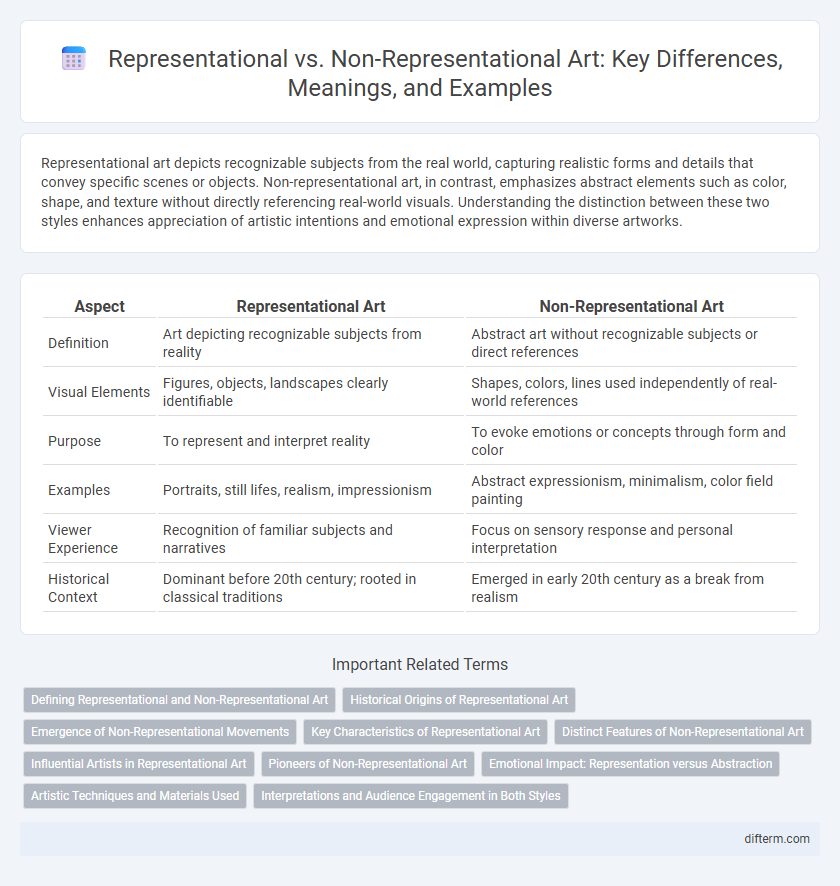Representational art depicts recognizable subjects from the real world, capturing realistic forms and details that convey specific scenes or objects. Non-representational art, in contrast, emphasizes abstract elements such as color, shape, and texture without directly referencing real-world visuals. Understanding the distinction between these two styles enhances appreciation of artistic intentions and emotional expression within diverse artworks.
Table of Comparison
| Aspect | Representational Art | Non-Representational Art |
|---|---|---|
| Definition | Art depicting recognizable subjects from reality | Abstract art without recognizable subjects or direct references |
| Visual Elements | Figures, objects, landscapes clearly identifiable | Shapes, colors, lines used independently of real-world references |
| Purpose | To represent and interpret reality | To evoke emotions or concepts through form and color |
| Examples | Portraits, still lifes, realism, impressionism | Abstract expressionism, minimalism, color field painting |
| Viewer Experience | Recognition of familiar subjects and narratives | Focus on sensory response and personal interpretation |
| Historical Context | Dominant before 20th century; rooted in classical traditions | Emerged in early 20th century as a break from realism |
Defining Representational and Non-Representational Art
Representational art depicts recognizable subjects from the real world, such as people, landscapes, and objects, aiming for accurate or stylized visual representation. Non-representational art, also known as abstract or non-objective art, avoids depicting physical reality, focusing instead on shapes, colors, forms, and textures to evoke emotions or ideas. Understanding the distinction lies in the intent to either mirror reality or explore purely visual elements without direct references to the natural world.
Historical Origins of Representational Art
Representational art emerged prominently during the Paleolithic era, with early cave paintings in Lascaux and Altamira depicting animals and human figures, reflecting a desire to capture reality visually. Ancient civilizations like Egypt and Mesopotamia further advanced this tradition by creating detailed sculptures and murals that conveyed religious and social narratives. This historical foundation underscores representational art's role in human culture as a means to preserve and communicate tangible experiences.
Emergence of Non-Representational Movements
The emergence of non-representational movements in art during the early 20th century marked a shift away from traditional figurative representation toward abstraction and expressionism. Artists such as Wassily Kandinsky and Piet Mondrian pioneered techniques that emphasized color, form, and emotion without depicting recognizable objects. This evolution reflected broader cultural changes and the desire to explore inner experiences beyond the visible world.
Key Characteristics of Representational Art
Representational art depicts recognizable subjects from the natural world, emphasizing accurate, detailed portrayals of objects, people, and landscapes. It relies on visual realism, perspective, and proportion to create lifelike images that relate directly to reality. This style often aims to convey narrative, emotion, or social commentary through clear, identifiable imagery.
Distinct Features of Non-Representational Art
Non-representational art emphasizes abstraction by foregoing recognizable subjects, focusing instead on color, form, and texture to evoke emotions and ideas. It often utilizes geometric shapes, dynamic brushstrokes, and unconventional materials to create visual experiences independent of real-world references. Key artists associated with this style include Wassily Kandinsky and Jackson Pollock, pioneers in expressing pure artistic expression beyond depiction.
Influential Artists in Representational Art
Influential artists in representational art include Johannes Vermeer, known for his detailed and realistic depictions of domestic scenes, and Diego Velazquez, whose portraits capture intricate human emotions and social status. Andrew Wyeth's works epitomize American realism, blending meticulous detail with emotional depth in rural settings. These artists emphasize accurate visual representation, making their work essential to the tradition of representational art.
Pioneers of Non-Representational Art
Wassily Kandinsky and Kazimir Malevich are celebrated pioneers of non-representational art, emphasizing abstract forms and colors over realistic depictions. Kandinsky's work explored spiritual and emotional expression through geometric shapes and vibrant hues, while Malevich introduced Suprematism, focusing on basic geometric figures like squares and circles to convey pure artistic feeling. Their innovations fundamentally shifted the art world, inspiring subsequent generations to break free from traditional representational constraints.
Emotional Impact: Representation versus Abstraction
Representational art conveys recognizable subjects, evoking emotional responses through familiar imagery and narrative clarity that allows viewers to connect personally and empathetically. Non-representational art relies on abstract forms, colors, and textures to elicit emotional reactions, often provoking introspection and ambiguous interpretations that transcend literal meaning. The emotional impact of abstraction lies in its ability to engage viewers' imagination, creating a subjective experience distinct from the concrete storytelling of representational works.
Artistic Techniques and Materials Used
Representational art employs traditional materials such as oil paints, charcoal, and canvas to depict recognizable subjects, emphasizing techniques like realistic shading, perspective, and anatomical accuracy. Non-representational art utilizes diverse media including acrylics, mixed media, and digital tools, focusing on texture, color field techniques, and abstract forms to convey emotion or conceptual ideas. Both approaches integrate brushwork, layering, and sculptural methods, but diverge in their manipulation of form and structure to either mimic reality or reject it entirely.
Interpretations and Audience Engagement in Both Styles
Representational art offers concrete imagery that allows viewers to connect through familiar subjects, facilitating clearer narrative and emotional engagement. Non-representational art emphasizes abstract forms and colors, inviting diverse interpretations and stimulating personal reflection. Audience engagement varies as representational works often guide viewers toward intended meanings, whereas non-representational pieces foster open-ended dialogue and imaginative participation.
representational vs non-representational Infographic

 difterm.com
difterm.com